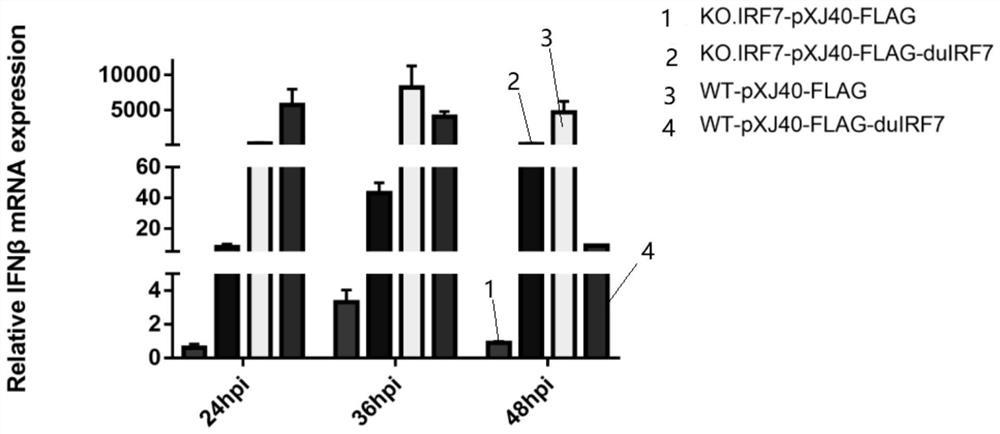Cell line with sgRNA, plasmid and IRF7 function deficiency as well as construction method and application of cell line
A technology for loss of function and method of construction, applied to cells modified by introducing foreign genetic material, genetically modified cells, DNA/RNA fragments, etc.
- Summary
- Abstract
- Description
- Claims
- Application Information
AI Technical Summary
Problems solved by technology
Method used
Image
Examples
Embodiment 1
[0055] Example 1 Construction of the sgRNA plasmid pX459-sgIRF7 for knocking out the IRF7 gene
[0056] 1. Design and screen to obtain the following two sgRNAs:
[0057] sgRNA-F: GGTCGTCGTTGCACTTGGAG (SEQ ID NO: 1);
[0058] sgRNA-R: CTCCAAGTGCAACGACGACC (SEQ ID NO: 2).
[0059] 2. Add Bbsl restriction sites (italics) at both ends of the sgRNA
[0060] sgRNA-F: CACCgGGTCGTCGTTGCACTTGGAG
[0061] sgRNA-R: AAACCTCCAAGTGCAACGACGACC c
[0062] The above primers were sent to Bioengineering Company for synthesis.
[0063] 3. Phosphorylation modification and annealing of the primers, the specific operation is as follows:
[0064] Resuspend the sgRNA with distilled water to a final concentration of 100 μM, add phosphate groups and anneal as follows, the specific process and formula can refer to Table 1.
[0065] Table 1
[0066]
[0067]
[0068] 4. Digest the pX459 vector with Bbsl:
[0069] Take 1 μg of the pX459 plasmid and digest it with Bbsl-HFTM for 30 minutes at 3...
Embodiment 2
[0079] Example 2 Screening IRF7 Functional Deficiency Cell Lines
[0080] 1. Culture DF-1 cells in 30mm flasks and transfect with pX459-sgIRF7 plasmid within 24 hours. For transfection, Thermo Fisher Lipofectamine LTX DNA Transfection Reagents Transfection Kit was used, and the transfection was carried out strictly according to the instructions of the kit.
[0081] 2. After the transfected cells were cultured for 36 hours, add puromycin to the culture dish to make the final concentration 5 μg / ml, and insist on replacing it with the cell culture medium containing puromycin (5 μg / ml) every 3 days. (If the cell density is too high, the cells need to be diluted and cultivated to facilitate the screening of a single cell line.) After 10 days, change the cell culture medium without puromycin every 5 days until obvious cell colonies appear (about 2 -3 weeks). We selected 10 cell colonies for single colony cell culture, and named these cell lines DF1-dIRF7-A1, DF-dIRF7-A2, DF1-dIRF7...
Embodiment 3
[0090] Example 3 Identification of the biological function of the IRF7 mutant cell line (KO IRF7)
[0091] 1. Cell growth characteristics
[0092] figure 1Shows the cell phenotype of wild-type DF-1 (DF1-WT) and KO IRF7 cells cultured for 12-96h. The results showed no significant difference between the two. The cells grew well at 12-36h, and after 48h, the cells appeared senescent or even died of old age (vacuole) due to contact inhibition.
[0093] The viability of DF1-WT and KO IRF7 cells was determined by CCK method and the growth curves were drawn. Methods as below:
[0094] The cell suspension was inoculated in a 96-well plate, 100 μl / well, 6 wells were set at each time point, and cultured at 37° C., 5% CO2. Take out the cells every 12 hours and add 10 μl CCK-8 to each well, mix gently to avoid air bubbles, then return to the incubator and incubate for 2 hours, then measure the absorbance at 450 nm with a microplate reader. Calculate the mean and standard error of th...
PUM
 Login to View More
Login to View More Abstract
Description
Claims
Application Information
 Login to View More
Login to View More - R&D
- Intellectual Property
- Life Sciences
- Materials
- Tech Scout
- Unparalleled Data Quality
- Higher Quality Content
- 60% Fewer Hallucinations
Browse by: Latest US Patents, China's latest patents, Technical Efficacy Thesaurus, Application Domain, Technology Topic, Popular Technical Reports.
© 2025 PatSnap. All rights reserved.Legal|Privacy policy|Modern Slavery Act Transparency Statement|Sitemap|About US| Contact US: help@patsnap.com



